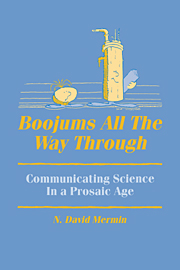Book contents
- Frontmatter
- Contents
- Preface
- I Reflections on the pursuit of physics
- II The quantum theory
- 10 Quantum mysteries for anyone
- 11 Can you help your team tonight by watching on TV?
- 12 Spooky actions at a distance: mysteries of the quantum theory
- 13 A bolt from the blue: the Einstein–Podolsky–Rosen paradox
- 14 The philosophical writings of Niels Bohr
- 15 The great quantum muddle
- 16 What's wrong with this pillow?
- III Relativity
- IV Mathematical musings
13 - A bolt from the blue: the Einstein–Podolsky–Rosen paradox
Published online by Cambridge University Press: 02 December 2009
- Frontmatter
- Contents
- Preface
- I Reflections on the pursuit of physics
- II The quantum theory
- 10 Quantum mysteries for anyone
- 11 Can you help your team tonight by watching on TV?
- 12 Spooky actions at a distance: mysteries of the quantum theory
- 13 A bolt from the blue: the Einstein–Podolsky–Rosen paradox
- 14 The philosophical writings of Niels Bohr
- 15 The great quantum muddle
- 16 What's wrong with this pillow?
- III Relativity
- IV Mathematical musings
Summary
Over fifty years ago Einstein, Podolsky, and Rosen published a striking argument that quantum theory provides only an incomplete description of physical reality – that is, that some elements of physical reality fail to have a counterpart in quantum-theoretical description. What made this a challenge to the quantum-theoretical Weltanschauung was the very mild character of the sufficient condition for the reality of a physical quantity on which their argument hinged: “If, without in any way disturbing a system, we can predict with certainty the value of a physical quantity, then there exists an element of physical reality corresponding to this physical quantity.” The argument consists in pointing out that it is possible to construct a quantum-mechanical state ψ with the following properties:
The state ψ describes two noninteracting systems (I and II). In almost all discussions the two systems are taken to be two particles, and the absence of relevant interaction is built in by taking ψ to assign negligible probability to finding the particles closer together than some macroscopically large distance.
By measuring an observable A of system I, one can predict with certainty the result of a subsequent measurement of a corresponding observable P of system II.
If, instead, one chooses to measure a different observable B of system I, one can predict with certainty the result of a subsequent measurement of a corresponding observable Q of system II.
The observables P and Q are represented in quantum theory by noncommuting operators, which means that they cannot both have definite values.
- Type
- Chapter
- Information
- Boojums All the Way throughCommunicating Science in a Prosaic Age, pp. 177 - 185Publisher: Cambridge University PressPrint publication year: 1990

